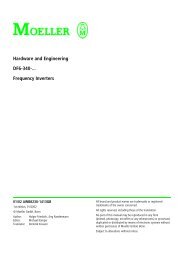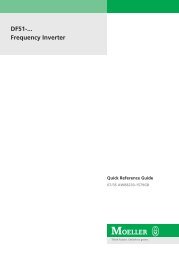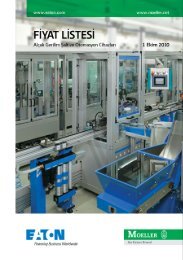Frequency Inverter DF51... - Moeller.com.tr
Frequency Inverter DF51... - Moeller.com.tr
Frequency Inverter DF51... - Moeller.com.tr
- No tags were found...
You also want an ePaper? Increase the reach of your titles
YUMPU automatically turns print PDFs into web optimized ePapers that Google loves.
04/07 AWB8230-1541GB BrakingBypass motor con<strong>tr</strong>olTo allow operation of a motor with both the frequency inverter anddirectly from the mains, the in<s<strong>tr</strong>ong>com</s<strong>tr</strong>ong>ing supplies must bemechanically interlocked:h Attention!A changeover between the frequency inverter and themains supply must take place in a voltage-free state.i Caution!The frequency inverter outputs (U, V, W) must not beconnected to the mains voltage (des<strong>tr</strong>uction of the device,risk of fire).Figure 14:Bypass motor con<strong>tr</strong>olh Attention!Switch S1 must switch only when frequency inverter T1 isat zero current.hQ1Q11T1M1S1L1 L2 L3I> I> I>L1 L2 L3U V WM3hContactors and switches (S1) in the frequency inverter’soutput and for DOL starting must be dimensioned forAC-3 and the motor’s rated power.BrakingMotor braking shortens unwanted deceleration distances andtimes. Braking can be mechanical or elec<strong>tr</strong>ical.Mechanical brakes act directly on the motor’s rotating shaft andexperience mechanical wear. The type of friction surface useddepends on the brake’s purpose:• Emergency-Stop braking• Normal braking during operation• Holding brakesElec<strong>tr</strong>ical braking – which does not cause wear – can beimplemented with frequency inverters:• DC braking• Regenerative braking• Dynamic brakingDC brakingIn DC braking – also called induction braking – the frequencyinverter supplies three-phase current to the motor’s three-phasestator winding. This creates a stationary magnetic field, which inturn induces a voltage in the moving rotor. Because the rotor’selec<strong>tr</strong>ical resistance is low, even small induction voltages cancause a high rotor current and therefore a s<strong>tr</strong>ong braking action.As the rotor slows down, the frequency of the induced voltage andwith it the inductive resistance drops. The braking effect of theresistive load increases, but the resulting braking torque abruptlydrops shortly before the rotor stops and disappears <s<strong>tr</strong>ong>com</s<strong>tr</strong>ong>pletely assoon as the rotor is stationary. DC braking is therefore not suitablefor holding loads or for intermediate braking. Once DC braking hasbeen activated, the motor <s<strong>tr</strong>ong>com</s<strong>tr</strong>ong>es to a standstill. Note also that DCbraking causes increased heat dissipation in the motor.Regenerative brakingWhen a motor is braked by reducing the output frequency(dynamic braking), the motor, driven by the load, can act as agenerator. This happens whenever the frequency inverter’s outputfrequency is lower than the motor’s speed. The cen<strong>tr</strong>ifugal energyis fed into the frequency inverter’s internal DC link, where itincreases the voltage. The frequency inverter monitors the voltageincrease and switches off when the highest permissible value isexceeded. A fault signal is issued.Regenerative braking applies an additional load to the frequencyinverter’s inverter. it should not exceed 10 % of the duration ofone operating cycle.With the resistance measurement described below, the system’sbraking capacity can be increased.25







